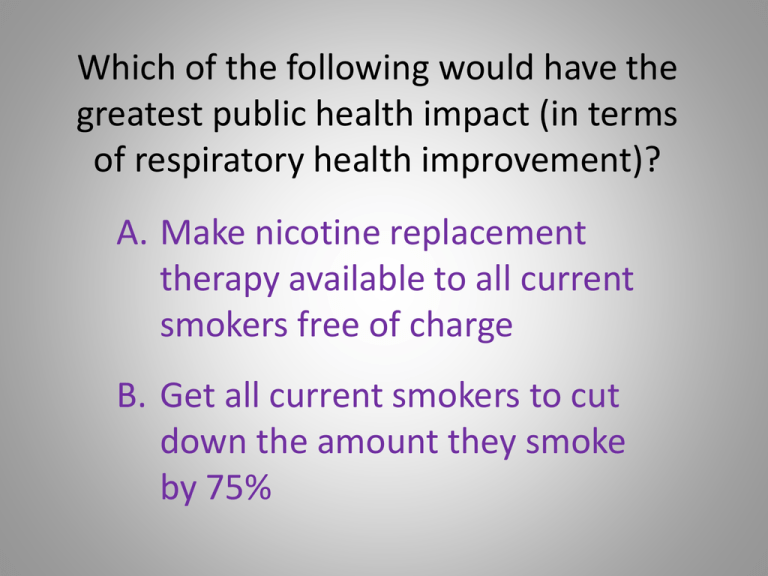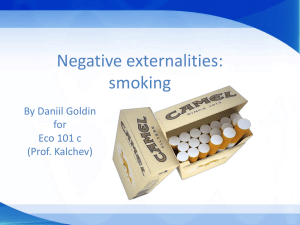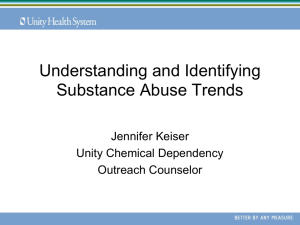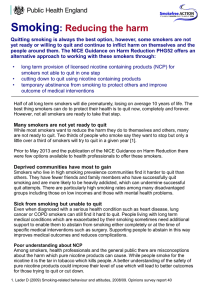
Which of the following would have the
greatest public health impact (in terms
of respiratory health improvement)?
A. Make nicotine replacement
therapy available to all current
smokers free of charge
B. Get all current smokers to cut
down the amount they smoke
by 75%
Assume population of 100 smokers, 20
cigarettes per day, and 8% NRT quit rate
A. Make nicotine replacement therapy available
to all current smokers free of charge 8%
cessation 8 people quit 160 fewer
cigarettes smoked per day
B. Get all current smokers to cut down the
amount they smoke by 75% 100 smokers
using 15 cigarettes less per day 1500 fewer
cigarettes smoked per day
Twist on the Prevention Paradox –
Focus on High-Risk for Quitting Rather
than High Risk for Disease
A. High-risk strategy: Intervene among the small
minority of smokers who are at high risk for
quitting (8% of population)
B. Population strategy: Shift entire distribution
of exposure (100% of population)
Source: Rose G. Sick individuals and sick
populations. Int J Epidemiol 1985; 14:32–38.
Is There a Product or Approach that Can Cut
Cigarette Consumption by 75% Among the
Population that Embraces the Product or Approach?
Is There a Product or Approach that Can Cut
Cigarette Consumption by 75% Among the
Population that Embraces the Product or Approach?
Is There a Product or Approach that Can Cut
Cigarette Consumption by 75% Among the
Population that Embraces the Product or Approach?
B. Population strategy: Shift entire distribution of
exposure (100% of population) by getting
smokers to switch to an alternative type of
cigarette that is substantially safer OR to cut
down on their cigarette consumption by 75%
or more
The Public Health Response
to Electronic Cigarettes
American Cancer Society: BAN THEM
American Heart Association: BAN THEM
American Lung Association: BAN THEM
Campaign for Tobacco-Free Kids: BAN THEM
Action on Smoking and Health: BAN THEM
American Legacy Foundation: BAN THEM
American Academy of Pediatrics: BAN THEM
Association for the Treatment of Tobacco Use and
Dependence: BAN THEM
Food and Drug Administration (FDA): PARTIALLY
ENFORCED A BAN ON THEM
The Debate Over
Harm Reduction in Public Health
“Scientific debates about public health issues can be heated, and
the arguments and feelings they provoke can become ad
hominem. Why do public health policy disputes often trigger
strong emotions including anger, contempt, and disgust?” …
“An example of a public health issue that can provoke emotional
disputes is harm reduction, an approach that seeks to
address public health problems in a practical way by reducing
harm as much as possible. … Debates about harm reduction
can quickly turn into emotional quagmires.”
Examples:
Abstinence-only sex education
Needle exchange programs
Harm reduction in tobacco control
Source: Alderman J, Dollar KM, Kozlowski LT. Understanding the origins of anger,
contempt, and disgust in public health policy disputes: Applying moral psychology
to harm reduction debates. Journal of Public Health Policy 2010; 31:1-16.
Should Medical Providers Recommend
E-Cigarettes to their Patients as a Smoking
Cessation Tool?
YES
Michael Siegel, MD, MPH
Professor
Department of Community Health Sciences
Boston University School of Public Health
Disclosure
Dr. Siegel has not received any funding or
compensation from any electronic cigarette
companies.
However, he is currently seeking funding from
electronic cigarette companies to conduct a
study of the effects of electronic cigarettes on
smoking behavior.
In 2007, the Answer was a
Resounding “NO”
All existing harm reduction products were produced by, and marketed
by the tobacco industry
Tobacco companies have no incentive to promote smoking cessation
using their harm reduction products
In practice, harm reduction products were used to promote dual use
of cigarettes and the alternative product
In practice, “harm reduction” products were not substantially safer
Marketing of these products undermined public’s appreciation of
health hazards of smoking
The 5 Most Common Arguments
Against Harm Reduction in Tobacco Control
1. Promotion of safer alternatives will inhibit smoking
cessation/prevention efforts
2. Skepticism about the role of combusted products in harm
reduction
3. Alternatives promoted as safer may prove more dangerous,
or equally dangerous, leading to false claims and misleading
of the public
4. NRT has not been effective, so harm reduction equals harm
maintenance
5. Tobacco industry cannot be trusted to develop and market a
safer cigarette alternative
Promotion of safer alternatives will inhibit
smoking cessation/prevention efforts
1. Smokers who switch to electronic cigarettes
are ex-smokers. They have successfully quit
smoking.
2. Electronic cigarette marketing is enhancing,
not detracting from, the public’s
appreciation of the hazards of cigarette
smoking.
Skepticism about the role of combusted
products in harm reduction
Electronic cigarettes are not
tobacco products and no
combustion takes place.
Alternatives promoted as safer may prove more
dangerous, or equally dangerous, leading to false
claims and misleading of the public
Product
Total Tobacco-Specific
Nitrosamines (ng/g or per
gum/patch)
Nicorette gum
2.00
NicoDerm CQ patch
8.00
Electronic cigarettes
8.18
Marlboro
6260
Source: Cahn Z, Siegel M. Electronic cigarettes as a harm reduction strategy for
tobacco control: A step forward or a repeat of past mistakes? Journal of Public
Health Policy 2010; doi:10.1057/jphp.2010.41.
NRT has not been effective, so harm
reduction equals harm maintenance
Abundant anecdotal evidence suggests that
electronic cigarettes may be effective for smoking
cessation.
Product addresses both the pharmacologic and behavioral
aspects of smoking addiction
Preliminary scientific evidence that vaping is effective in
decreasing the desire to smoke
Vibrant online community of vapers
Tobacco industry cannot be trusted to
develop and market a safer cigarette
alternative
Electronic cigarettes are not
tobacco products and only 3 of
more than 300 brands are
marketed by tobacco companies.
An Ethical Framework
for Thinking About Harm Reduction
Nonmaleficence
“To do no harm”
An Ethical Framework
for Thinking About Harm Reduction
Nonmaleficence
“To do no harm”
New
Products
Existing Products
An Ethical Framework
for Thinking About Harm Reduction
Nonmaleficence
“To do no harm”
New
Products
Existing Products
(THE CASE OF
CHANTIX)
The Consequences of
Failing to Apply an Ethical Framework to
Issues of Harm Reduction
Highly toxic product
Kills 400,000 people
each year
FDA Stamp of Approval
Sale and marketing
approved by the FDA
FDA Would
Rather
Smokers Do
This
Much safer product
Not known to kill
anyone
FDA Seal of Scorn
Effectively banned by
the FDA
Than Quit
Smoking
and Do This
Hypothetical Question
What if we had a non-tobacco, non-combustion
device that looked and worked like a cigarette
but delivered clean nicotine, was satisfactory to
smokers, helped them to quit smoking or greatly
reduce the amount that they smoked, and were
relatively safe?
We already do!
The future is here.
The electronic cigarette
(or some sort of non-tobacco cigarette)
is the future for smoking cessation
in the U.S.
WHY?
Theme #1:
Bio-behavioral feedback
• Vaping mimics smoking
•
•
•
•
oral stimuli
throat hit
vapor cloud
inhalation
• Maintains smoking associations
•
activities (drinking, eating, coffee, driving)
• Ability to swap e-cigarettes into normal daily
smoking routine
Theme #1:
Bio-behavioral feedback
• “That feeling when it comes down and hits your
throat and you inhale it, that's like a big deal for us
all.”
• “[…] when I quit cigarettes, my fixation with you
know, vaping is very similar. So I like to vape while
I'm in the car, I like to vape while after I have a meal
or when I have a coffee or when I'm drinking and so
on, so it mirrors that almost.”
Theme #2:
Social benefits
• There is a vaping community
•
•
Online community forums
Social support
• There is a social support network in the vaping
community
•
•
Vaping clubs
Vapefests
Theme #2
Social benefits
• “Going to the website and you start hearing people’s
stories […] you research until you find something
and I kept coming back to this and really liked it.
There’s a big support community ethic, which is part
of it.”
• “You don't hear about 2 people on the patch talking
about their patches or what brand their trying or
what not.”
Theme #3
Hobby elements
• Vaping as a hobby
•
•
•
•
Mixing and matching e-cigarette parts and juices
Choosing flavors
Neat devices
Skill formation
• Sense of personal control
•
You are making the decisions
Theme #3:
Hobby elements
• “I learned about […] the different bases and juices.
There's so much knowledge out there and I became
a nerd. And it became a hobby.”
• “I like all the flavors, I like the devices. You know, it's
my new hobby, my new collection. I don't collect
lighters now, I'm collecting juice and devices.”
Theme #4
Personal identity
•
•
•
•
Users self-identify as “vapers”
You take on a new identity
Re-define your identity
Sub-identities (type of e-cigarette; type of flavors)
•
•
•
•
atomizer vs. cartomizer
type of flavor
prepared cartridges or fill your own
PG or VG
Theme #4:
Personal identity
• “You know, for years, I loved being able to carry
around my pack of cigarettes and my Red Sox lighter.
I miss carrying my Red Sox lighter. I still could but
it'd be stupid. That's how you feel about your
lighter; it's your Red Sox lighter. It becomes who
you are. It becomes, you don't do anything without
a cigarette in your hand. Now I can still do that and
still get the nicotine without disgusting somebody
else because I am smoking and it does stink.”
Theme #5:
Smoking cessation vs. nicotine cessation
• Smoking cessation with NRT or other drugs requires
nicotine cessation; quitting smoking with ecigarettes does not
• Many smokers do not want to quit using nicotine; ecigarettes allow them to quit smoking anyway
(unlike any other smoking cessation drug)
• Users can make the choice and retain control over
whether they want to be tobacco-free or nicotinefree
Theme #5
Smoking cessation vs. nicotine cessation
• “When I first started that was the plan [weaning off
nicotine]. But I enjoy it, now. I don't see anything
wrong with it.”
• “My goal is to be nicotine free at some point but I’m
not in a hurry either.”
Conclusion
Why Electronic Cigarettes are
the Wave of the Future
• Electronic cigarettes address the psychological,
behavioral, and social aspects of smoking addiction
and not just the pharmacologic aspects (unlike any
traditional smoking cessation product)
• Electronic cigarettes appeal to the core values of:
•
•
•
•
Identity
Autonomy
Control
Social Support
Recommendations
Where do we go from here?
• Address safety issues
•
•
•
•
Battery safety
Ideal excipient (concern about long-term PG inhalation
and VG leading to formaldehyde formation)
Presence of aldehydes
Quality control
• Address efficacy issues
•
Efficiency and consistency of nicotine delivery
Recommendations
Where do we go from here?
• Address regulatory issues
•
•
•
Possibility of modified product provisions, which would be a disaster
Are smoking cessation claims therapeutic claims in the absence of an
intention to treat nicotine dependence?
Need a unique regulatory framework; a simple “deeming” regulation
putting e-cigarettes under the same requirements as cigarettes
would be disastrous to the public’s health
• Address public health opposition
Should Medical Providers Recommend
E-Cigarettes to their Patients as a
Smoking Cessation Tool?
The Answer
Scenario #1
A 59 year-old male presents with exertional
dyspnea and is found to have early signs of
COPD. He expresses a desire to quit smoking,
although he has never attempted to quit in the
past. He doesn’t mention anything about ecigarettes but says he had two friends who quit
using the patch.
Scenario #2
A 59 year-old male presents with exertional
dyspnea and is found to have early signs of
COPD. He expresses a desire to quit smoking. He
has tried to quit unsuccessfully multiple times in
the past, using methods including cold turkey,
NRT, and Chantix. He just found out about ecigarettes and is excited to try them. Two of his
friends just quit using e-cigarettes.
What Would It Take to Justify Not
Recommending E-Cigarettes?
• Not substantially safer than cigarettes
• Inhibit smoking cessation
• Enhance nicotine or smoking addiction
The Evidence
Not substantially safer than cigarettes
• FALSE – Overwhelming evidence
Inhibit smoking cessation
• FALSE – Overwhelming evidence
Enhance nicotine or smoking addiction
• FALSE – Very strong evidence
Conclusion
Electronic cigarettes are one viable approach to
smoking cessation that are available to the
clinician.
There is no reason why this approach should not
be offered to at least some patients, those for
whom the clinical situation suggest that this
approach could be effective.







